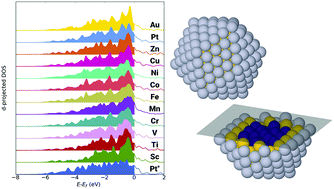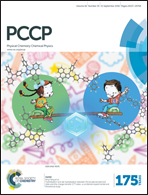Decoupling strain and ligand effects in ternary nanoparticles for improved ORR electrocatalysis†
Abstract
Ternary Pt–Au–M (M = 3d transition metal) nanoparticles show reduced OH adsorption energies and improved activity for the oxygen reduction reaction (ORR) compared to pure Pt nanoparticles, as obtained by density functional theory. The strain and ligand effects in nanoparticles are decoupled and correlated with the extended Pt(111) surface for benchmarking. The ternary metal in the core allows for tuning the catalytic activity through strain effects. Pt–Au–M for M = Cr, Mn, Co, Cu, Zn nanoparticles are of particular interest as they exhibit an optimal contribution of strain, ligand effects and stability. Good agreement is found with experimental studies showing increased activity of Pt–Au–Fe/Ni nanoparticles, and mid to late 3d transition metals are predicted to exhibit enhance activity and stability with respect to pure Pt nanoparticles.



 Please wait while we load your content...
Please wait while we load your content...